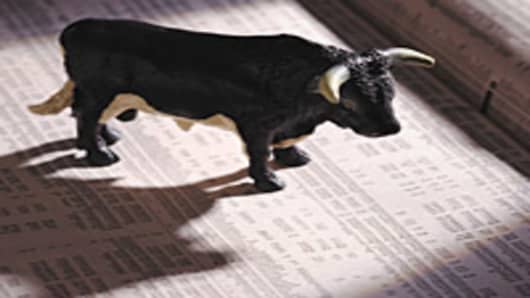Federal Reserve easing has helped fire up one of the strongest stock market rebounds ever, and the promise of more is keeping it going.
The chart of the S&P 500's more-than-100 percent run—from its March 2009 low of 666 to its current 1340-plus level—generally depicts the most powerful comeback of the past seven cyclical stock market recoveries, Wells Fargo Advisors analysts say.
Yet, unlike some of those other periods, the economic recovery has been sluggish and nearly stumbled.
In the nearly three-year run, the S&P 500 reached its cyclical high of 1,370 in May 2011. That was just before the Fed's "QE2," or its second quantitative easingprogram came to an end at the end of June. The Fed purchased $600 billion Treasury securities under that program in an effort to drive rates lower and send investors into riskier assets — like stocks.
From May through early October, the stock market moved lower as the debt ceiling debate raged in Washington, and the economy and Europe worried markets.
The S&P bottomed in early October at 1,074, just as the Fed embarked on yet another program, "operation twist." The "twist" involves Fed purchases of longer duration Treasurys, using the proceeds from sales of shorter term securities.
The S&P 500 since then has gained more than 22 percent, hitting occasional bumps related to the European debt crisis.
Coincidental or not, the Fed has been there whenever the bull has needed an extra push.
Stuart Freeman, chief equity strategist for Wells Fargo Advisors, said the Fed's easing programs, aside from the improved economy, has definitely been a factor driving stocks.
"We probably wouldn't have reached 1,370 until maybe the middle of this year" were it not for the Fed's activity, said Freeman. He noted that the announcement of QE2 last year drove the S&P well above the rest of the prior stock rebound cycles by April and May, and well above his then year end target of 1,250-1,275. (see chart above)
Freeman says that as QE2 came to an end, investors anticipated that the economy might slow without help from the Fed, and it proceeded to move lower during the softer economic period last summer. The S&P, at that point, was performing below the levels of recoveries in the early 1980s and the early 1970s.
He cautions the same thing could happen this year, with the bull galloping too far ahead of where it may ultimately end up finishing the year. Feeding the bull once more is the promise of more Fed easing.
"If we continue to see this market move in a short period of time back to the 1,400 level or above, in the short run our thought would be, it may well be ahead of itself," said Freeman. His year-end target is 1,325 to 1,375.
Recent stronger economic data, particularly the January employment report, has dampened some expectations for more Fed easing. But Fed Chairman Ben Bernanke this week emphasized to a Senate committee that the unemployment rate is still too high and the numbers mask a worse jobs picture.
San Francisco Fed President John Williams, in a speech Wednesday, also held out the prospect of more QE. He said if the economy loses momentum and inflation remains well below 2 percent, the Fed could do more asset purchases, specifically aimed at mortgage-backed securities.
Freeman said the market is now factoring in a "QE3" program. The market has been expecting a program aimed at housing, with the Fed buying billions of dollars of mortgage securities.
Others agree. "The Fed has created an environment where it's painful not to take risk," said Ward McCarthy, chief financial economist at Jefferies. "You have real negative rates across the entire yield curve. So if you want inflationto erode the value of your principle, the message is to stay in Treasurys."
McCarthy expects the Fed to announce QE3, and the Fed chairman will use every opportunity to make a case for it, as he did in Congressional testimony twice in the past two weeks.
Follow Patti Domm on Twitter: @pattidomm



